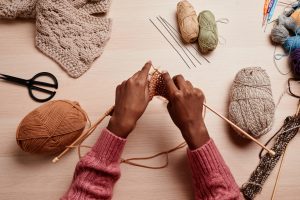How to Get Started with Knitting
 Anyone can learn to knit! It doesn’t take some special crafting gene, and you don’t need superhuman dexterity (or even a lot of patience). You just need to follow a few basic rules and, most important, you have to want it. What follows is our guide to getting started with knitting. With the right guidance, you could be on your way to your favorite new hobby.
Anyone can learn to knit! It doesn’t take some special crafting gene, and you don’t need superhuman dexterity (or even a lot of patience). You just need to follow a few basic rules and, most important, you have to want it. What follows is our guide to getting started with knitting. With the right guidance, you could be on your way to your favorite new hobby.
Pop culture and general wisdom will tell you that your first project should be a scarf. Do not do this. Scarves take forever to finish, they show errors very obviously and, most of all, nobody really wants one. For a lot of people who quit early on, “I gave up on knitting” actually means “I gave up on knitting a scarf I grew to hate.”
Instead, after you’ve mastered the basics of knitting — don’t worry, we’ll get to that — try your hand at a hat. They take far less time, mistakes are much less obvious and hats are beloved by everyone who has a head. They’re more complicated, but that means you’ll learn more.
Another reason new knitters give up is that projects can sometimes drag on, so try to give yourself a deadline for your first: maybe you’ll want to wear the completed item on an upcoming trip or to give it to someone for their birthday.
Last, accept that it’s O.K. to be bad at something when you’re first starting out. As adults, we so rarely try things we’ve never experienced before, and there’s truly something liberating in sucking for a week or two before finally getting the hang of it.
First, acquaint yourself with your local yarn store. Smaller, independent shops tend to be more personal — though generally more expensive — while big box stores like Michaels and JOANN are often less pricey and less intimate.
If going to a physical location isn’t an option, you can order your materials from an online store like WEBS, which stocks an enormous variety of yarn, needles, and notions at all price points, or Knitpicks, which carries its own affordable house brands. If at all possible, touch your yarn before you buy it, because not only are you going to spend a ton of time with it, you’re also going to want to actually like the end product.
For those first few projects, generally, you’ll want yarn that’s medium-weight, otherwise known as worsted — not as thin as dental floss nor as thick as rope — and make sure to read its label to figure out which size needles you should buy to go along with it (generally sizes 6 to 9). Don’t worry too much about your first needles; the size is the important thing, and what they’re made of (bamboo, aluminum, plastic) and how they look (straight versus circular) is more a matter of preference than anything else.
A lot of local libraries, religious institutions, and YMCA-type establishments offer knitting groups, and online databases like Meetup.com can be a great way to find circles or even just teachers in your area as well. And if you learn best one-on-one, find a friend, family member, neighbor, or member of a community group who’s willing to go over the basics with you.
If you prefer to learn on your own and you’re willing to invest some cash, check out a fee-based online course like those offered by Craftsy, which provides video tutorials and step-by-step instructions for students of all levels. You can preview each instructor’s videos to see if you like their vibe, their speed, and their voice — an important thing, especially because you’ll have to rewind at least a few times before you get the steps down.
Finally, you can buy preassembled kits of materials that come with directions for beginners. Kits like these can cost more than it would be to buy the materials à la carte. Still, they’re designed to go along with their accompanying pattern, and the quality is generally high.
If you’re not willing or able to spend money, there are plenty of free online resources, although, without some structure or oversight, the risk of quitting can increase. The videos from KnittingHelp.com are clear and well-paced. As with Craftsy, it might take some digging around to find an instructor that you really like.
Block out a chunk of time in your schedule to put some initial time into whichever learning method you prefer. It should be at least a couple of hours with minimal interruptions at first (although soon you should be able to knit and listen to a podcast or watch TV). When you’re first starting out, try to do multiple sessions in a short time period — a good beginner’s pace is about three times per week.
Give yourself time to learn the following techniques: casting on, the knit stitch, the purl stitch, decreasing, increasing, and casting off. Each of these will take some trial and error, but once you know them, you’ll be able to make most beginner patterns. (And don’t forget to take breaks to stretch your hands.)




